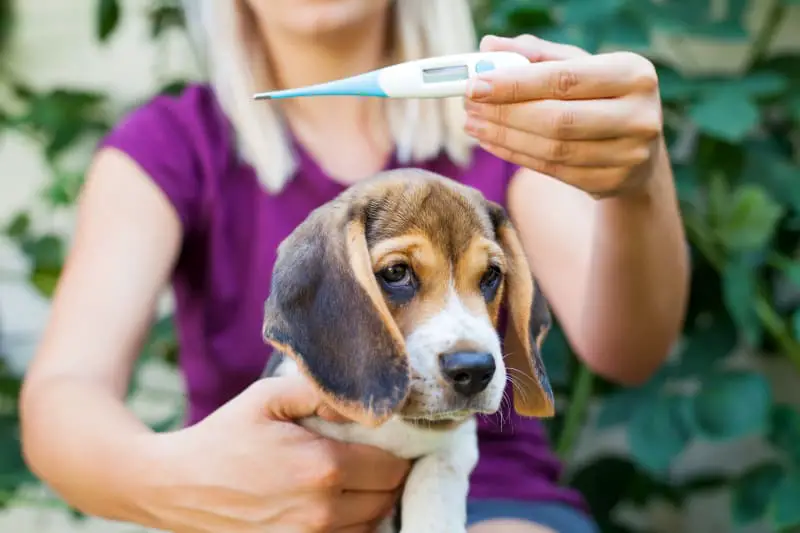How to Comfort Your Dog with a Fever: Tips and Tricks
When your dog is sick with a fever, it can be a stressful time for both you and your pet. Understanding how to recognize and care for a dog with a fever is crucial for their recovery.
This guide provides essential steps to recognize signs, seek veterinary help, and provide comfort at home. Get all the necessary knowledge to support your dog’s path to recovery.
Key takeaways
Recognize signs of fever in your dog: lethargy, loss of appetite, and increased body temperature.
Consult a veterinarian for proper diagnosis and treatment.
Provide a comfortable resting area for your dog’s recovery.
Ensure your dog stays hydrated with fresh water.
Use cool towels or gentle grooming to lower body temperature.
Administer prescribed medications as directed.
Monitor closely and seek veterinary help if the fever persists or worsens.
Offer comforting activities like gentle petting or soothing music.
Create a calm environment to aid recovery.
Show love and reassurance to your dog during this time.
Recognizing the Signs of Fever in Dogs
Normal body temperature for dogs
A dog’s normal body temperature ranges from 101.0°F to 102.5°F (38.3°C to 39.2°C). If your dog’s temperature is above this range, they may be experiencing a fever. It’s essential to understand that a dog’s normal body temperature is slightly higher than that of humans, so what may feel warm to you might be normal for your canine companion.
Symptoms indicating a fever
Recognizing the signs of a fever in your dog is vital for timely intervention and care. Common symptoms include:
- Lethargy: A dog with a fever may seem sluggish, unresponsive, or disinterested in their surroundings and daily activities.
- Shivering: Although shivering can occur for various reasons, it may be a sign that your dog is trying to raise its body temperature to fight off an infection or inflammation.
- Loss of appetite: A dog experiencing a fever may lose interest in food, even if it’s their favorite treat.
- Vomiting: Vomiting can accompany a fever as your dog’s body tries to eliminate toxins or cope with the discomfort.
- Nasal discharge: A runny or congested nose can indicate that your dog is battling an infection, which may also cause a fever.
Causes of fever in dogs
Fevers in dogs can be caused by a variety of factors, such as:
- Infections: Bacterial, viral, or fungal infections can trigger a fever as the immune system works to combat the invading pathogens.
- Inflammation: Inflammatory conditions like arthritis, pancreatitis, or immune-mediated diseases can also lead to fevers in dogs.
- Toxins: Exposure to toxic substances, such as antifreeze, certain plants, or insecticides, can cause a fever as the body tries to fight off the harmful effects.
- Heatstroke: Overexertion or prolonged exposure to high temperatures can result in heatstroke, which can cause a fever.
- Unknown causes: In some cases, the underlying cause of a fever may not be immediately apparent. It’s crucial to consult your veterinarian if your dog’s fever persists without a clear cause.
Checking Your Dog’s Temperature
Importance of monitoring temperature
Monitoring your dog’s temperature is essential to determine if they have a fever and track their progress throughout the recovery process. Regular temperature checks can also help you assess the effectiveness of any treatments and decide when it’s time to consult your veterinarian.
Different types of thermometers
There are several types of thermometers you can use to check your dog’s temperature:
- Rectal thermometer: A rectal thermometer, either digital or mercury-based, is the most accurate method to measure your dog’s temperature. Make sure to lubricate the thermometer with petroleum jelly or a water-based lubricant before insertion.
- Ear thermometer: These thermometers are specifically designed for dogs and measure the temperature inside your dog’s ear canal. Although slightly less accurate than rectal thermometers, they can still provide a good indication of your dog’s temperature.
- Infrared thermometer: This non-contact option measures temperature by scanning your dog’s ear or forehead. While convenient and less invasive, they may be less accurate than rectal or ear thermometers.
Step-by-step process for taking a dog’s temperature
Follow these steps to measure your dog’s temperature using a rectal thermometer:
- Ensure your dog is calm and relaxed. You may need the assistance of another person to hold your dog gently but firmly in place.
- Lubricate the thermometer with petroleum jelly or a water-based lubricant.
- Lift your dog’s tail and gently insert the thermometer into their rectum, about 1-2 inches deep.
- Hold the thermometer in place and wait for the thermometer to beep or for the recommended amount of time, as per the manufacturer’s instructions.
- Carefully remove the thermometer and check the reading. Clean the thermometer with rubbing alcohol or soap and water before storing it.
Remember, if your dog’s temperature is above the normal range, consult your veterinarian for guidance on how to proceed.

When to Consult Your Veterinarian
Signs that require immediate veterinary attention
While some mild fevers can be managed at home, it’s crucial to know when professional veterinary care is necessary. Seek immediate veterinary attention if your dog:
- Has a temperature above 104°F (40°C) or below 99°F (37.2°C).
- Exhibits symptoms such as labored breathing, rapid heart rate, or disorientation.
- Has a fever that persists for more than two days, even with home care.
- Experiences a fever in conjunction with other severe symptoms, such as vomiting, diarrhea, or difficulty walking.
Importance of consulting a veterinarian
Consulting a veterinarian is vital in determining the underlying cause of your dog’s fever and ensuring they receive the appropriate treatment. A veterinarian can perform diagnostic tests, prescribe medications, and provide guidance on how to manage your dog’s fever most effectively.
How a veterinarian can help
Your veterinarian plays a critical role in your dog’s recovery from a fever by:
- Conducting a thorough physical examination and medical history to identify potential causes of the fever.
- Performing diagnostic tests such as bloodwork, X-rays, or ultrasounds to confirm or rule out specific conditions.
- Prescribing medications or treatments tailored to your dog’s needs and the underlying cause of the fever.
- Advising you on how to properly care for your dog at home and offering recommendations for preventing future fevers.
Remember, early intervention and consultation with your veterinarian can help ensure your dog’s rapid recovery and prevent potential complications.

Comforting and Caring for Your Dog at Home
1. Keep your dog hydrated
Ensuring your dog stays hydrated is crucial during a fever, as they may lose fluids due to panting, vomiting, or decreased appetite. Provide access to fresh, clean water at all times and encourage your dog to drink by offering ice chips or adding water to their food.
2. Provide a comfortable environment
Creating a calm and soothing environment for your dog can help them rest and recover more effectively:
- Soft bedding: Set up a comfortable bed with soft blankets or towels, offering extra padding for support and warmth.
- Adjusting room temperature: Keep the room temperature moderate, ensuring it’s not too hot or cold for your dog. This will help them maintain a stable body temperature.
- Noise control: Minimize loud noises and disruptions to help your dog rest undisturbed.
3. Offer low-fat, easily digestible food
Your dog’s appetite may decrease during a fever. Offer small, frequent meals of low-fat, easily digestible food, such as boiled chicken and rice or a prescription diet recommended by your veterinarian. Avoid giving them fatty or heavily spiced foods that may upset their stomach.
4. Encourage rest and limit activity
Rest is vital for your dog’s recovery. Encourage your dog to relax by providing a quiet, comfortable space for them to rest. Limit their physical activity and avoid engaging them in high-energy play or exercise during this time.
5. Consider using a cooling pad
A cooling pad can provide relief and help lower your dog’s body temperature if they have a high fever. Always monitor your dog while they’re using a cooling pad, ensuring they’re not becoming too cold or uncomfortable.
6. Offer reassurance and emotional support
Your presence and comforting touch can have a significant impact on your dog’s recovery. Spend time with your dog, offering gentle pets, soothing words, and emotional support to help them feel safe and secure during this challenging time.

Home Remedies and Over-the-Counter Medications
Warning: human medications can be dangerous for dogs
It’s important to note that many human medications can be toxic or harmful to dogs. Never administer any human medication to your dog without first consulting your veterinarian.
Safe OTC medications for dogs (with veterinarian’s approval)
With your veterinarian’s approval, there are some over-the-counter (OTC) medications that may be safe for your dog. These can include:
- Buffered aspirin: Buffered aspirin can help reduce fever and inflammation in dogs. Be sure to follow your veterinarian’s dosage recommendations, as too much aspirin can cause stomach upset or other side effects.
- Canine-specific fever reducers: Some OTC medications are specifically formulated for dogs, such as canine fever reducers. Always follow the label instructions and consult your veterinarian before administering any medication.
Herbal remedies and supplements
Some natural remedies and supplements may help boost your dog’s immune system and support their recovery, such as:
- Echinacea: This herb may help enhance your dog’s immune response, but always consult your veterinarian before introducing any new supplement to your dog’s diet.
- Probiotics: Probiotics can support a healthy digestive system and improve your dog’s ability to absorb nutrients, which can be beneficial during their recovery.
The role of honey and bone broth in recovery
Incorporating honey and bone broth into your dog’s diet may help support their recovery:
- Honey: Honey has natural antibacterial properties and can help soothe a sore throat or cough. You can mix a small amount of honey into your dog’s food or offer it as a treat.
- Bone broth: Bone broth is nutrient-rich and can provide hydration and essential nutrients for your dog during their recovery. Ensure the broth is free of added salt or seasoning and serve it at room temperature.
Remember to always consult your veterinarian before introducing new medications, supplements, or remedies to your dog’s care routine.

Preventing Future Fevers
Prevention is always better than cure. By taking proactive steps, you can minimize the risk of your dog experiencing fevers in the future:
Keeping your dog up-to-date on vaccinations
Vaccinations can protect your dog from many common illnesses and infections that could potentially cause fevers. Work with your veterinarian to ensure your dog receives all necessary vaccinations on schedule.
Maintaining a healthy diet and exercise routine
A well-balanced diet and regular exercise can help support your dog’s immune system and overall health. Ensure your dog receives the appropriate amount of nutrients and engages in activities that match their age, breed, and physical capabilities.
Regular veterinary check-ups
Scheduling regular check-ups with your veterinarian can help detect and address any potential health concerns early, reducing the risk of future fevers. Your veterinarian can also recommend preventive measures tailored to your dog’s specific needs.
Identifying and avoiding potential triggers
Understanding the potential causes of your dog’s fever can help you take preventive steps to avoid future occurrences. Keep your dog away from known triggers, such as toxins, allergens, or specific environments that may cause stress or illness.
By being proactive in your dog’s health and wellbeing, you can reduce the likelihood of fever episodes and ensure your furry friend remains happy and healthy.

Frequently Asked Questions about Comforting a Dog with a Fever
Can I use a human thermometer to check my dog’s temperature?
Yes, you can use a human thermometer (preferably digital) to check your dog’s temperature. However, ensure you designate this thermometer solely for your dog’s use and clean it properly after each use.
Is it safe to give my dog ibuprofen or acetaminophen for fever?
No, ibuprofen and acetaminophen can be toxic to dogs, even in small doses. Consult your veterinarian for appropriate fever-reducing medications for your dog.
How long does a fever typically last in dogs?
A fever’s duration in dogs can vary depending on the underlying cause. Most mild fevers resolve within 24-48 hours with appropriate care. However, if your dog’s fever persists beyond two days or worsens, consult your veterinarian.
Should I try to cool my dog down with a cold bath or ice packs if they have a fever?
Avoid using extremely cold water or ice packs, as this can cause your dog to shiver and raise their body temperature further. Instead, you can use a cooling pad or tepid water to gently cool your dog down. Always monitor your dog to ensure they are not becoming too cold or uncomfortable.
Can stress cause a fever in dogs?
Stress can contribute to a weakened immune system, which may make your dog more susceptible to infections that can cause fever. Although stress may not directly cause fever, managing your dog’s stress levels is essential for maintaining their overall health.
What if my dog refuses to take the medication prescribed by the vet?
Consult your veterinarian for alternative methods of administration or alternative medications. Some suggestions include hiding medication in food or using flavored, chewable tablets.
How can I tell if my dog’s fever is breaking?
A reduction in your dog’s temperature is a sign that the fever is breaking. Additionally, improvement in their energy levels, appetite, and demeanor are indicators that the fever is subsiding.
Are certain breeds more susceptible to fevers than others?
While any dog can develop a fever, certain breeds may be more susceptible due to genetic predispositions or breed-specific health issues. Always consult your veterinarian for breed-specific guidance.
Remember, always consult your veterinarian if you have concerns about your dog’s fever or health. They are your best resource for ensuring your furry friend receives appropriate care and treatment.
Final Thoughts
Caring for a dog with a fever can be a challenging and emotional experience. By familiarizing yourself with the signs of fever, understanding when to consult your veterinarian, and learning how to provide comfort and care at home, you can help your furry friend on their journey to recovery.
In this comprehensive guide, we’ve covered essential information to help you recognize, monitor, and comfort your dog during a fever, as well as provided answers to frequently asked questions. Remember, always trust your instincts as a pet owner and seek professional veterinary advice if you’re concerned about your dog’s health. By being proactive and attentive to your dog’s needs, you can ensure they remain happy, healthy, and fever-free.






